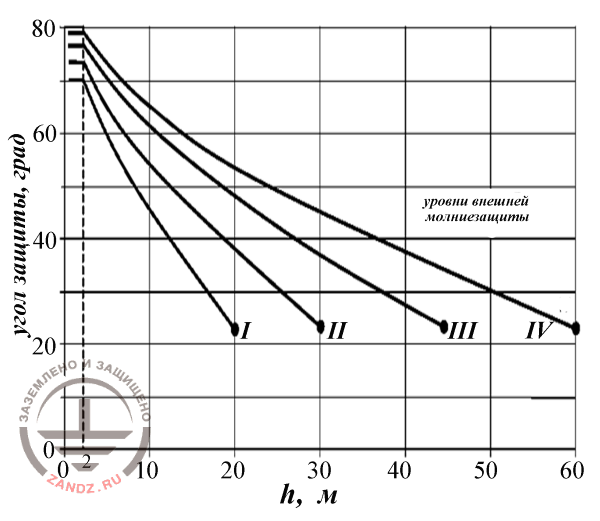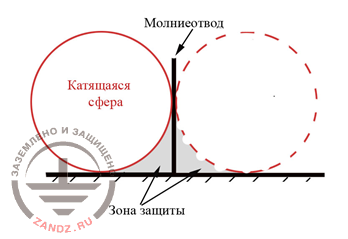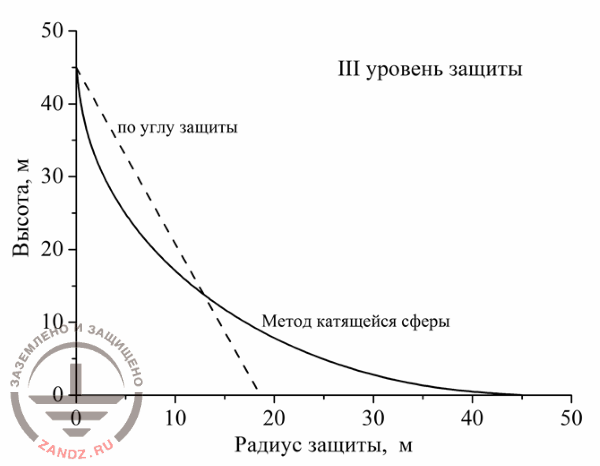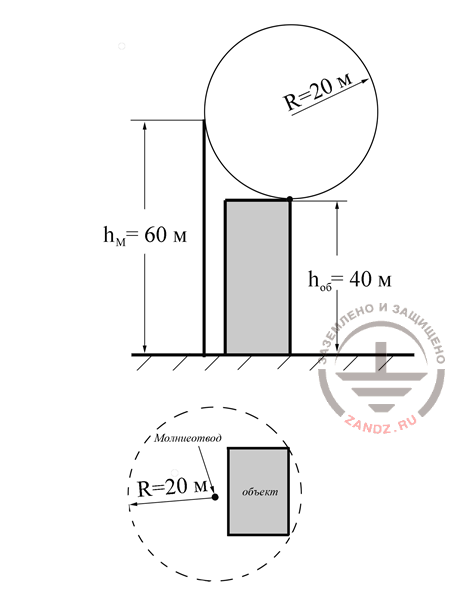The first part of the article "How to choose lightning rods after all?"
Protection zones in IEC standard are defined by two independent ways: with the protection angle α and with the rolling sphere method. Protection angle sets the inclination of a side surface of a circular cone to its vertical axis. The angle value depends on the exceeding of h top of the lightning rod over the flat surface, on which the protected object was installed (fig. 1). According to IEC standards, value h cannot exceed 20,30,45 and 60 m for levels of protection I, II, III and IV with the protection reliability 0,98, 0,95, 0.9, 0,8 correspondingly.

Fig. 1 Protection angle depending on the exceeding of the lightning rod over the installation place of the protected object at different protection levels
Угол защиты, град – protection angle, degrees
Уровни внешней молниезащиты – external lightning protection levels
It is impossible to define, what was the base for the certain protection angle values in the IEC standard and how they correspond to the experiece of using rod lightning rods and catenary wire lightning rods for which these values are supposed. As known, any authentic information about protective action of lighting rods is accumulated by CIGRE for high-voltage electric lines, but, at a quite restricted range of heights, and the main thing - for relatively small exceedings of catenary wire lightning rod over the protected object - wire. Half a century ago, these results were summarized by emperic formulas in [9,10] where the following equations for the probability of a lightning breakthrough Pпр and for the same parameter, expressed in percentage Рпр% were recieved:
 (1)
(1)
 (2)
(2)
Here h - height of catenary wire lightning rod regarding the ground surface, and α is angle between the vertical axis and the straight, connecting the wire with the protected wire (in fact, the same protection angle). It is quite difficult to use these data for approbation of IEC methodics. As already mentioned, they cover not a great range of heights of catenary wire lightning rods and their exceedings over the protected wires. Besides, the values of exceedings are not involved in imperic formulas (1) and (2).

Fig. 2 Lightning protection by rolling sphere method
Молниеотвод – lightning rod
Катящаяся сфера- rolling sphere
Зона защиты – protection zone
According to rolling sphere method, the border of the protection zones is set by the trace, left after a sphere of the set radius, if it is rolled around the rod lightning rod (fig. 2). For protection levels I, II, III and IV, the spheres with the radii R=20,30,45 and 60 are respectively set. Construction in fig. 3 demonstrates how protection zones do not coincide with the probability of a lightning breakthrough 0,1 (III protection level), built by these two methods for h=R =45 m. As, at the height of 30 m, the radius of protection, found the method of a rolling sphere, is twice smaller, than at the protection angle.

Fig. 3 Comparison of protection zones, built at the protection angle and rolling sphere method
Высота. М – height, m
По углу защиты – by the protection angle
III уровень защиты – III protection level
Метод катящейся сфера – rolling sphere method
Радиус защиты, м – protection radius, m
The situation is reverse at the ground level. IEC standard doesn't contain any explanations for that.
Methodologically, it is useful to distract from the precision of the discussed methods and see what peculiarities of lightning rod functioning set on practice are reflected in IEC standard. It is necessary to start with the most obvious fact, confirmed by the centuries of using lightning rods. They protect the object with the required reliability at a significant elevation over the object. Protection reliability won't exceed 0,5 when the height of the object and lightning rod of a classical execution are equal. It means, the top of the protection zone may not coincide with the top of the lightning rod and should be located below it, the further ∆h than the required protection reliability. This undoubtful principle of lightning rod functioning was completely ignored by IEC method. Protection zones, found by the protection angle and by the rolling sphere method, may start directly from the top of the lightning rod.
The second question concerns the ultimate sizes of the protection zones of single lighting rods. According to the protecton angle, the zone is defined only for some certain exceeding of the lightning rod over the surface on which the protected object is located. If, for instance, it is mounted on the ground, then at the I protection level (with the reliability 0,98) the estimations can be made only for height not more than 20 m. At the protection angle 22,5o, the radius of the protection zones on the ground level will be equal to 8,3 m. IEC doesn't discuss what will happen at the further increase of the lightning rod height. The effort to use rolling sphere method in this situation cannot clarify anything, as, according to fig. 2, increase of lightning rod height h over the rolling sphere radius R doesn't influence the sizes of a single rod protection zone. In that regard, we would like to pay attention to the two crucial moments. The first one refers to emperical calculation formula (1) and (2), made on the base of CIGRE real data. At the protection angle 22,5o and protection reliability 0,98 they give ultimate heights of lightning rods in 84,7 and 56,25 m but not 20 m. The difference is too serious to unreasonably neglect it.

Fig. 4 To the question of ambiguity of rolling sphere method
Молниеотвод – lightning rod
Объект - object
Another moment is commented on fig. 4, where building of the protected volume is carried out according to the rules of rolling sphere method. Rod lightning rod 60 m high stands on the ground sruface, as well as the object 40 m high and thus, is not inside the protective zone volume. It is the same, as for a 20-meter rod. The situation changes crucially, if a grounded tape, which can act as a lightnign rod is laid along the edge of the object roof on the side, further from the lightning rod. Now the whole object and significant space above it, according to IEC standard turns out to be protected with the reliability 0,98 corresponding to I protection level. The effect of the tape, not elevating above the roof even to 1 cm is miraculous, but inexplicable from the position of gas charge physics.
IEC standard pays special attention to the use of lightning protection mesh. Meshes with the sizes of 5х5, 10х10, 15х15 m and 20х20 m on a flat surface guarantee protection from a lightning breakthrough with the probability, corresponding to I, II, III and IV levels. At that, metal mesh conductors can be laid directly on an incombustible roof or be Δh = 0.15 m above it, when the roof is easily combstible. In other words, to capture lightning with a lightning protection mesh with the probability up to 0,98 practically doesn't require any elevation above the roof.
This is the time to see the data from fig. 1, taken from IEC standard, where protection angles are presented depending on the exceeding of the lightning rod above the roof. For I-IV protection level at small elevations, α protection angle varies within 70-78o. It means, that the width of the protection zones on the roof surface at the elevation of mesh of 0,15 m cannot be greater than 0,295- 0,415 m instead of the required 2.5-10 m. Such a principal discrepancy was left without any attention in the standard.
The application of rolling sphere method for the estimation of mesh efficiency gives the result, depending on its elevation above the roof Δh. The mesh with the interval between the cells D provides protection of a flat roof surface, if
 (3)
(3)
where R - rolling sphere radius for the studied protection level. It is useful to note, that a significant discrepancy of the estimation results acoording to the protection angle and rolling sphere method coms from (3).
The result of the analysis cannot be considered reassuring. IEC standard user has to be kept in the dark regarding the origin of the values of standardized protection angles and rolling sphere radii for different protection levels, and the main thing - it is not capable to get any compatible results, using these methods and also the lightning protection mesh method.
E. M. Bazelyan, DEA, professor
Energy Institute named after G.M. Krzyzanowski, Moscow
Read more "2. Selection of lightning rods in the national regulatory documents"
See also:
- Useful materials for grounding and lightning protection designers
- Free webinars with the leading industry experts
- Real-life examples of grounding and lightning protection calculations
Related Articles:
 Lightning protection of residential and public buildings - answers to frequently asked questions in the design
Lightning protection of residential and public buildings - answers to frequently asked questions in the design
 Lightning Protection of Large Territories: Parks, Grounds, Plant Territories. Page 1
Lightning Protection of Large Territories: Parks, Grounds, Plant Territories. Page 1
 Lightning Protection of Large Territories: Parks, Grounds, Plant Territories. Page 2
Lightning Protection of Large Territories: Parks, Grounds, Plant Territories. Page 2
 Lightning Protection of Large Territories: Parks, Grounds, Plant Territories. Page 3
Lightning Protection of Large Territories: Parks, Grounds, Plant Territories. Page 3

